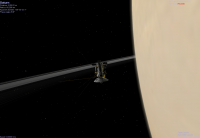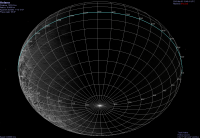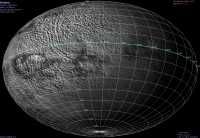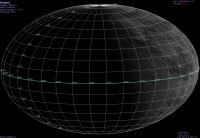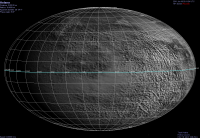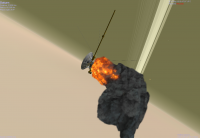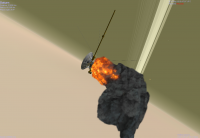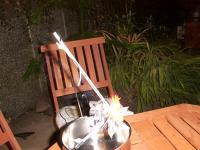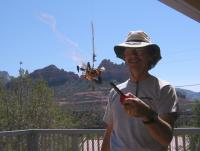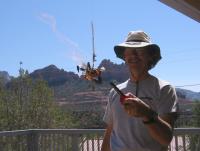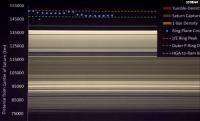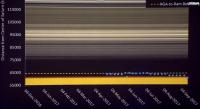Printable Version of Topic
Click here to view this topic in its original format
Unmanned Spaceflight.com _ Cassini general discussion and science results _ Cassini's Extended-Extended Mission
Posted by: volcanopele Feb 6 2009, 03:35 AM
Perhaps now would be a good time to start a new thread on the Extended-Extended Mission.
http://www.space.com/news/090127-cassini-mission-extension.html
Posted by: brellis Feb 6 2009, 05:28 AM
One hopes the thruster swap doesn't affect any decision on long term planning - http://www.sciencedaily.com/releases/2009/02/090202161457.htm
Posted by: Juramike Feb 6 2009, 03:38 PM
Wait....what?
(from space.com article)
"such as evidence of what appear to be cryovolcanoes spewing extremely cold liquid into the atmosphere of Titan."
Did someone detect lower temperature spray actively venting????
Posted by: volcanopele Feb 6 2009, 05:26 PM
VIMS may have detected photometric changes at Hotei Arcus and in a region of Western Xanadu.
http://gishbar.blogspot.com/2008/10/dps-meeting-so-far.html
Posted by: Juramike Feb 6 2009, 06:01 PM
Ahhh, OK, I get it:
The material when erupted would have been "extremely cold" by our standards, but probably warmer than the surface temp by Titan standards.
(So, an erupting plume of locally cooler material was NOT detected on Titan)
Sorry if I got a little pedantic, I wanted to confirm I hadn't missed something....
Posted by: volcanopele Feb 6 2009, 10:09 PM
Of course, I didn't start this thread completely randomly:
http://saturn.jpl.nasa.gov/news/significantevents/significantevents20090205/
Today at the Executive Session of the Cassini Project Science Group
meeting, a tour was selected from among four candidates to be part of
a proposal to be made to NASA next week for a follow-on mission after
the current extended Cassini mission is complete.
Posted by: ngunn Feb 6 2009, 10:41 PM
Does that mean that a tour has to be selected before the go-ahead is given for another extension? That seems the wrong way round to me.
BTW Do you know what the four candidates were? (Yes or no will do.)
Posted by: volcanopele Feb 6 2009, 10:56 PM
Yes, I do know what the four candidates were. The one selected is pretty good and it seemed to please the most groups in Cassini (obviously, why else would it be selected). I preferred some of the Titan flybys in another tour, but since the tour selected won't exactly match the one that will be flown, who knows, maybe one the Nav guys and gals can adjust one of the Titan flybys to look like one of the ones from one of the tours not selected.
Well, in a way it might seem like the backward way to go, but when you propose a plan to NASA for an extended mission, it is probably a good idea to have... a plan: a plan for how you plan to spend the money you are requesting and a plan for how the extended mission will look. We can go to NASA and tell them what we plan on doing in 2016, how many moons we will fly by, and how many times.
Posted by: Greg Hullender Feb 6 2009, 11:00 PM
When I read about this last year
http://www.lpi.usra.edu/opag/march_08_meeting/presentations/spilker.pdf
I read that the prime mission had managed to get radar coverage of 22% of Titan's surface and that the XM would get an additional 8% -- for a total of 30% across 6 years. There was no mention of how much the 7-year XXM might get, but it would be nice to know. Is it reasonable to hope for an additional 20% coverage (for 50% total)?
--Greg
Posted by: volcanopele Feb 6 2009, 11:03 PM
At this point we have JUST selected which tour we want to fly, and at this point, it is too early to start slicing it up until we know kind of funding we will be look at for the XXM.
Posted by: jsheff Feb 7 2009, 01:50 AM
Can you give us any highlights? Any Iapetus flybys?
Posted by: stevesliva Feb 7 2009, 05:23 AM
The image of passing between the rings and he cloudtops is a nice tease...
Posted by: volcanopele Feb 20 2009, 10:06 AM
Nope, we don't come any closer than 900,000 km of Iapetus.
There are some nice encounters currently planned. Quite a few Titan and Enceladus (12 < 10000 km) encounters. The long mission does afford quite a few nice encounters of some of the other moons. If you like little rocks, mark May 20, 2012 on your calender (Methone and Telesto). Someone must really like Helene for some reason...
Posted by: Mariner9 Feb 20 2009, 04:50 PM
Twelve more close Enceladus encounters???? Oh joy. More skeet shoots. More global mosaics. More 'sniffing' the plumes.
A lot of people, myself included, get a bit morose when we think about how long it will be before the next Saturn mission arrives. But I am heartened by something I heard once in a lecture at JPL.
Ellen Stofan was giving a talk on discoveries at Io by the Galileo mission. I think an audience member asked her if she had any regrets about the high gain antenna problem, and the data she had lost because of it. She told us of a conversation with a Voyager researcher, who had said that he did most of his research on Io based on about 20 key images from Voyager. She went on to say that she did wish they had some additional thermal map images, but she was pleased with the rest of the data set, and wasn't even sure if she would be able to handle much more.
I'm sure she was putting a bit of a positive spin on things, but it was an interesting point. Twenty of the right pictures are worth more than 200 images at random. By the end of Cassini's mission we will have had more than twenty close flybys of Enceladus, with a carefully selected set of gravity, fields, particles, and remote sensing data.
And that ain't chicken feed.
Posted by: Byran Feb 21 2009, 10:27 AM
volcanopele, when publish the complete list of all flybys the Cassini's Extended-Extended Mission mission?
Posted by: Greg Hullender Feb 21 2009, 07:34 PM
Probably some French guy from USC.
--Greg :-)
Posted by: Del Palmer Feb 21 2009, 09:19 PM
From the latest Cassini Significant Events report:
"A two-day NASA Senior Review of a proposal for a Cassini Extended Extended Mission (XXM) concluded today. The review board's comments and questions indicated that they were quite impressed with the science, science team, and technical presentations, and that they understood and appreciated the XXM plans, rationale, and concerns. Within a month the final review board report should be available and some time after that a final decision is expected from NASA Headquarters."
They were only quite impressed? ![]()
Posted by: ugordan Feb 21 2009, 09:34 PM
How close?
Posted by: Hungry4info Feb 21 2009, 10:00 PM
A 12 km Enceladus flyby sounds nice =) (When do we finally land? ![]() )
)
I, actually, find the rock moons rather interesting.
Has Mimas ever gotten close flyby?
Posted by: volcanopele Feb 21 2009, 10:07 PM
No, no, I meant that there are 12 encounters of Enceladus with C/A distances of less than 10,000 km.
The Helene encounter is currently around 1800 km on June 18, 2011.
Looks like both flybys (the other being on March 3, 2010 at 1820 km) will allow for nearly global imaging of the small body so that after the two flybys, Helene should be pretty well mapped.
Posted by: Hungry4info Feb 21 2009, 10:18 PM
Posted by: dmuller Feb 21 2009, 11:07 PM
I found a website which lists 4 different scenarioes for the XXM at http://www.mpi-hd.mpg.de/dustgroup/cassini/xxm/xxm.html
Anybody has any idea as to which one is most likely to be chosen?
Posted by: volcanopele Feb 21 2009, 11:41 PM
It was SM-7.
Posted by: ilbasso Feb 22 2009, 01:16 AM
Just heard Carolyn Porco speak at Spacefest this afternoon. She saved Enceladus for last in her talk, and she spent more time talking about it than she did about Titan. In discussing the XXM, she was most excited about the additional Enceladus flybys, and also about the ring plane crossings.
Posted by: jasedm Feb 22 2009, 09:52 AM
Anybody has any idea as to which one is most likely to be chosen?
Some very tempting options here, and a tough call for those making the decision - two of the rejected trajectory options include close flybys of Hyperion (and yet still managed to allow 10 close Enceladus encounters into the bargain) - it would have been fantastic to get another set of very close views of Hyperion from a different perspective.
By my reckoning (if it isn't already) Enceladus will be easily the most intimately-known object outside of Mars' orbit at the end of the XXM.
Posted by: Greg Hullender Feb 22 2009, 05:12 PM
Is there something that indicates what sort of Titan coverage we might get during the XXM?
--Greg
Posted by: ugordan Feb 22 2009, 05:20 PM
Thanks. That's close, will Cassini be able to track Helene the whole encounter - angular rates and all that?
Too bad about the missed opportunities to re-image Hyperion, that moon makes for great poster material.
Posted by: dmuller Feb 23 2009, 05:26 AM
Have a look at http://www.mpi-hd.mpg.de/cassini/xxm/SM-7/SM-7_all.txt
That seems to be what's in the running, but I have no further insights other what's been said on this forum and that website
Posted by: Floyd Feb 23 2009, 02:47 PM
Cassini having a very bad day ![]()
Posted by: stevesliva Feb 23 2009, 04:14 PM
Yes, I see the problem. Your collision simulation clearly has a poor representation of the resulting "explosion."
Posted by: djellison Feb 23 2009, 04:49 PM
Nothing unusual about that news release.
Posted by: Byran Feb 23 2009, 04:52 PM
- 55 Titan
- 11 ENCELADUS (in 2651, 49, 48, 49, 1208, 49, 49, 49, 81, 1800, 2234, 49, 4999 km)
- 3 DIONE (in 199, 523, 510 km)
- 2 RHEA (in 200, 2300 km)
- EPIMETHEUS (in 3125 km)
- METHONE (in 1453 km)
- TELESTO (in 2867 km)
- HELENE (in 1807 km)
Posted by: Bjorn Jonsson Feb 23 2009, 07:28 PM
As previously discussed there are no targeted Hyperion flybys. However, there are some pretty close nontargeted flybys:
HYPERION 2010-332T03:31:35 Nov28 Sun Inbound 71598.9 km flyby, v = 4.9 km/s, phase = 73 deg
HYPERION 2011-237T17:50:51 Aug25 Thu Outbound 48781.7 km flyby, v = 5.2 km/s, phase = 106 deg
HYPERION 2011-259T13:22:45 Sep16 Fri Outbound 57347.5 km flyby, v = 4.8 km/s, phase = 84 deg
HYPERION 2012-068T01:21:42 Mar08 Thu Inbound 93452.2 km flyby, v = 5.5 km/s, phase = 148 deg
HYPERION 2015-151T13:42:21 May31 Sun Outbound 35456.9 km flyby, v = 4.3 km/s, phase = 71 deg
The last flyby in particular is at much closer range than any of the flybys so far with the exception of the targeted flyby.
In addition there are several flybys of Mimas at significantly closer range than the closest flyby (~61,000 km) of the primary mission. There are also many nontargeted flybys of Tethys including two flybys closer than 10,000 km. The W/NW part of Odysseus isn't particularly well imaged, hopefully this 'gap' gets filled.
There are many nice flybys of Rhea. There isn't very good stereo coverage near 0° longitude. Hopefully that relatively small 'gap' gets filled - I want a high resolution DEM of Rhea's *entire* surface ![]() .
.
Lots of nontargeted Dione flybys as well and many flybys of the small 'rocks'.
I'm a bit surprised there are no Voyager class (~100,000 km) Iapetus flybys since there was a ~120,000 km flyby early in the mssion and that one was by luck/accident and not planned. It happened when the first few months of Cassini's trajectory were altered in response to problems with the Cassini - Huygens communcations.
This is going to be a very interesting extension to the mission provided everything goes well.
Posted by: Mariner9 Feb 24 2009, 04:32 AM
Any estimates available on annual cost of the XXM? I recall reading that current mission costs are running about 80 million dollars. They had hoped to get that down to 40 million a year, but it was deemed impractical to go that low.
Posted by: Holder of the Two Leashes Feb 24 2009, 06:51 PM
The last flyby in particular is at much closer range than any of the flybys so far with the exception of the targeted flyby.
Boy, so am I. Biggest disappointment of the XXM.
Posted by: paxdan Feb 24 2009, 09:44 PM
http://www.planetary.org/blog/article/00001856/ wow! The view from 3800 km is going to be awesome
Posted by: ngunn Feb 24 2009, 10:17 PM
Following the 'proximal' link I've just read that piece by John Spencer. Made me wish I had a hat to throw in the air. I always said we needed a long lived 'weather satellite' for Titan in particular, now it seems that Casssini can take on that assignment and a lot more besides. Will it be funded? Well I don't think NASA will ever be offered so much science at so small a cost.
Posted by: Holder of the Two Leashes Feb 24 2009, 10:24 PM
Clicked on the link Paxdan provided for the Planetary Society. Now that's a story!
Kudos to the Cassini team for their great planning and hard work. I appreciate the fact that they tried to work in another Iapetus encounter. It just wasn't in the cards.
Volcanopele's cryptic picture now makes perfect sense. So this is how the journey will end. Not with a whimper, I trust. Hope Cassini is transmitting right to the end.
Posted by: HughFromAlice Feb 25 2009, 04:18 AM
I've just read John Spencer's "Solistice Mission" article on Emily's blog. It made me extend my lunch break as it was such a fantastic read!! Let's just hope that the team can make a proximal orbit around the money and get the required slingshot effect to take us to the pay off on September 15 2017!!!
Posted by: ngunn Feb 25 2009, 09:32 PM
I know most people who come here keep an eye on TPS too but it seems appropriate to link to the excellent new flybys diagram for Cassini's whole mission, existing and proposed:
http://www.planetary.org/blog/article/00001857/
It's breathtaking how much one spacecraft can undertake.
Posted by: Thu Feb 26 2009, 01:06 PM
You're absolutely right!
From the diagram we can easily find out that the more Titan flybys, the less icy moons' and vice versa. Well, we cannot get both of them for free
Posted by: ugordan Feb 26 2009, 01:37 PM
Of course, we are yet to find out if it's able to handle such a long extension.
Knock on wood.
Posted by: remcook Feb 26 2009, 06:28 PM
Great write-up!
In the (pretty) graphic representation of the mission Emily posted today on her blog it mentions G Arc flybys, one of them taking place next year. What are the observations like for these?
Posted by: HughFromAlice Feb 27 2009, 02:17 PM
If you mean why are these observations being made then ...........The G arc is part of the G ring - a faint ring about mid way between the F and E rings. There is a bright bulge or arc for about a sixth of the ring circumference that is held in place by an orbital resonance with Mimas. I think the interest in studying this is that the properties of the arc strongly suggest that it is the remnants of a small icy moon (small = about 250m diameter) that broke up quite recently in astronomical terms (maybe a few hundred thousand years ago?). So obs from a close range will give us more information on its dynamical properties, size of constituents etc as a step forward in understanding how the rings of Saturn may have formed.
If you mean what observations are to be made, then I don't know!
Good that the mission is not to be extended for too long - the G ring is expected to dissipate within the blink of an astronomical eye - a few thousand years!
Posted by: Byran Mar 25 2009, 09:55 AM
http://www.lpi.usra.edu/opag/march_08_meeting/presentations/spilker.pdf
I read that the prime mission had managed to get radar coverage of 22% of Titan's surface and that the XM would get an additional 8% -- for a total of 30% across 6 years. There was no mention of how much the 7-year XXM might get, but it would be nice to know. Is it reasonable to hope for an additional 20% coverage (for 50% total)?
--Greg
http://www.jpl.nasa.gov/news/news.cfm?release=2009-058
About 38 percent of Titan's surface has been mapped with radar so far. On March 27, Cassini will complete its 52nd targeted flyby of Titan.
Posted by: floron Apr 23 2009, 10:40 PM
About 38 percent of Titan's surface has been mapped with radar so far. On March 27, Cassini will complete its 52nd targeted flyby of Titan.
is the 38% figure including the low-res scatterometer coverage?
ftp://ftp.lpi.usra.edu/pub/outgoing/lpsc2009/full254.pdf page 11
Posted by: jasedm Jun 27 2009, 11:55 AM
"A two-day NASA Senior Review of a proposal for a Cassini Extended Extended Mission (XXM) concluded today. The review board's comments and questions indicated that they were quite impressed with the science, science team, and technical presentations, and that they understood and appreciated the XXM plans, rationale, and concerns. Within a month the final review board report should be available and some time after that a final decision is expected from NASA Headquarters."
They were only quite impressed?
Hi all,
If there was an announcement on XXM funding, I've missed it. The above goes back to February - does anybody know when a decision can be expected on a go/no-go for the XXM?
Posted by: ngunn Jan 25 2010, 08:04 PM
Anybody know when a decision is to be reached on this? There seems to be a lot of Cassini news today, and the tour highlights for all of 2010 appearing on the Cassini website did make me wonder if something could be happening.
Posted by: john_s Jan 25 2010, 08:55 PM
We hope to know more after the President's 2011 NASA budget is released in early February. However it's very unlikely that the plug will be pulled with only a few month's notice, so it's a pretty good bet (but with no guarantees) that the current 2010 flight plan will be executed as currently planned.
John
Posted by: tharrison Jan 26 2010, 01:15 AM
It would also be horrible PR to pull the plug on a fully functional mission simply due to budgets.
Posted by: jasedm Jan 27 2010, 05:33 PM
Oh it will surely happen - there's the definitive proof of the Rhea rings to confirm yet, the further radar coverage of Titan, the incomparable PR generated by the 'proximal orbits' and so on.
A saturn orbiter is surely priceless.
Posted by: ugordan Jan 27 2010, 05:56 PM
There's nothing to confirm just yet. There is no discovery, only tantalizing hints and from what I've seen in various ISS observations apparently targeted at imaging the rings, that's going to be a very tough nut to crack. Not sure how other instruments would be able to nail the case. Would RADAR be able to get any reflection from a few boulders some thousands of km away?
Posted by: tedstryk Jan 27 2010, 07:33 PM
The evidence is from particle and fields data (MIMI), not ISS. There is something there, the question is what that something is.
Posted by: ugordan Jan 27 2010, 08:31 PM
I realize where the claim comes from. Didn't the same instrument pick up hints of activity on Dione? Highly suggestive and tantalizing stuff, but I wouldn't exactly call it evidence by itself. Yes, there definitely appears to be something there around Rhea, but we have no proof it's rings, hence my comment about confirmation with other instruments.
Posted by: ynyralmaen Jan 27 2010, 09:19 PM
The broad electron depletion seen by MIMI in 2005 can apparently be explained by a broad disk of debris orbiting Rhea; further narrow dropouts on either side of the moon suggested that discrete rings could be embedded in a more diffuse disk. CAPS also saw a similar broad decrease during a more distant flyby in 2007; both the flybys were downstream, so not providing the full picture of the plasma-moon/debris interaction. The next close Rhea flyby's little over a month away on March 2nd; inbound slightly downstream of Rhea in the plasma flow, outbound slightly upstream - maybe we'll get a better picture of what's going on there from those observations.
Hints of activity at Dione came from the magnetometer data, and some have interpreted features seen by CAPS as being signs of plasma release at Dione and Tethys.
Posted by: Elias Jan 28 2010, 12:17 AM
The magnetometer did not actually pick up hints of activity at Dione. It has detected a field deformation that could occur if newly produced ions (e.g. ionized products from an exosphere around Dione) are added to the surrounding plasma flow. The inference of activity is based on the lack of direct evidence that a substantial exosphere exists around Dione, and from theoretical calculations suggesting/(confirming?) that surface sputtering from plasma cannot account for any considerable exosphere around that moon.
So practically, what was detected were hints of mass addition near the moon. The origin of this mass addition is still undetermined, but the favored scenario is that there is activity. On the other hand, we now know that around the period of the flyby, Dione was immersed in a new radiation belt (produced after a solar storm impacted Saturn) , the presence of which could have modified the sputtering rates and have produced a transient exosphere...
One flyby is never enough...
Posted by: volcanopele Jan 28 2010, 12:23 AM
69 days, 4 hours, 53 minutes and 17 seconds until D2
Posted by: Ron Hobbs Jan 30 2010, 05:52 AM
Did I miss something?
In the 1/27 press release on the http://www.jpl.nasa.gov/news/news.cfm?release=2010-032&icid='NewsFeaturesHome' flyby, it says that this will be the "22nd Titan encounter in Cassini's Solstice Mission." ![]()
I am sure that it is a slip of the pen, but it is almost certainly a good sign that john_s is right and the Solstice Mission is a go. Can't wait for the formal announcement, though.
And I really can't wait for those proximal orbits.
Posted by: Phil Stooke Jan 31 2010, 05:14 PM
Isn't solstice what we're in now?
Phil
Posted by: volcanopele Jan 31 2010, 05:39 PM
No, we are still in the Equinox mission until July 1.
Posted by: Ron Hobbs Jan 31 2010, 05:43 PM
I thought we were still in the Equinox Mission, at least until the middle of this year. As far as I know, XXM, otherwise known at the Solstice Mission, has not yet been formally approved. Maybe it will be in the budget that we will see tomorrow.
Posted by: Phil Stooke Jan 31 2010, 06:02 PM
"No, we are still in the Equinox mission until July 1."
Oh yeah - well, I knew something was lining up.
Phil
Posted by: ngunn Feb 1 2010, 10:08 PM
Do you think we can construe 'continues operating 11 planetary missions' (from Van Kane's digest of today's budget proposals) as approval of the solstice mission?
Posted by: Greg Hullender Feb 2 2010, 01:49 AM
Oh I think they'll approve it. The cheapest kind of mission is the one you don't have to launch. And how can they resist the grand finale?
--Greg
Posted by: volcanopele Feb 3 2010, 08:23 PM
Now it's official and approved ![]()
![]()
![]()
![]()
![]()
![]()
![]()
![]()
![]()
![]()
![]()
http://saturn.jpl.nasa.gov/news/newsreleases/newsrelease20100203/
Posted by: ugordan Feb 3 2010, 08:29 PM
w00t!!! ![]()
Posted by: djellison Feb 3 2010, 08:31 PM
2017 baby ![]()
Posted by: machi Feb 3 2010, 08:34 PM
Finally! ![]()
![]()
![]()
Posted by: volcanopele Feb 3 2010, 08:34 PM
The only sad part, you can now mark on your calenders, September 15, 2017:
Posted by: ugordan Feb 3 2010, 08:37 PM
If it manages to live that long and remains in good health, I don't think we'll really have reasons to be sad. More like grateful for what will have been a truly great mission.
Posted by: SFJCody Feb 3 2010, 08:51 PM
When that time arrives I will give my paper model of Cassini the same send off I gave my paper model of Galileo on September 21, 2003.
Posted by: volcanopele Feb 3 2010, 08:57 PM
Wow, I should do the same thing. I built my paper model (now squished, with a detached HGA and a missing Huygens) the weekend Cassini launched...
Posted by: SFJCody Feb 3 2010, 09:00 PM
Mine has also seen some wear and tear over the years. I think it's in a shoebox somewhere at the moment. I tied a bit of cotton to Huygens to stop it from going missing.
Posted by: canis_minor Feb 3 2010, 09:06 PM
Beware the ides of September....
Posted by: SFJCody Feb 3 2010, 09:11 PM
John
Posted by: Ron Hobbs Feb 3 2010, 11:09 PM
[quote name='volcanopele' date='Feb 3 2010, 12:34 PM' post='154945']
The only sad part, you can now mark on your calenders, September 15, 2017:
Oh, but think of all the sights we will see and all the cool things we will learn.
Oh, boy, oh boy, oh boy! I am so looking forward to this.
On to the proximal orbits!
Posted by: volcanopele Feb 3 2010, 11:17 PM
Quite right, there are quite a few great things before that fateful day, and besides that's not for another 7 years! We get seven more years of Cassini awesomeness, not to mention Dawn, Juno, New Horizons, and MESSENGER before the end of Cassini.
Posted by: ugordan Feb 3 2010, 11:29 PM
To put it into perspective, Cassini's mission at Saturn up until now was shorter than that. And the prospect of having Cassini live to witness Rosetta and New Horizons prime science missions... Here's hoping for that!
Posted by: dmuller Feb 4 2010, 01:57 AM
Updated my http://www.dmuller.net/spaceflight/realtime.php?mission=cassini with the good news! Cassini has now completed 61.8% of its mission by time and 68% by distance flown. Distance to fly to impact estimated to be 2.5 bn km w.r.t. Sun, 16.9AU. Does anybody have a SPICE kernel for the extended mission?
Also updated the http://www.dmuller.net/spaceflight/mission.php?mission=cassini&appear=black&mtype=scet&showimg=yes&dispwide=no ... it's one long page by now! I assumed that it is still XXM - SM7 that's being flown.
Go Cassini!
Posted by: volcanopele Feb 4 2010, 03:13 AM
I use ftp://naif.jpl.nasa.gov/pub/naif/CASSINI/kernels/spk/091005AP_SCPSE_09248_17265.bsp
This covers the period from mid-September 2009 until the end of the mission. You definitely want to switch to this as I am sure this will affect the timings of many of the non-targeted events.
Posted by: dmuller Feb 4 2010, 03:31 AM
Aaaah that's the one to use, thanks a lot. Must have missed the file end date. Will update the flying distances in a couple of hours.
I don't think it will change encounter times, I took those from http://www.mpi-hd.mpg.de/cassini/xxm/SM-7/SM-7_all.txt ... unfortunately I'm not blessed with trajectory analysis software etc that can nicely spit out encounters. I still live in the time of state vectors and Pythagoras ... and I am NOT going to calculate all those 1400+ events manually!
Posted by: remcook Feb 4 2010, 09:23 AM
Yay! Bring on those seasonal variations! ![]()
Posted by: MahFL Feb 4 2010, 11:25 AM
Awesome, 7 years.
Posted by: belleraphon1 Feb 4 2010, 01:00 PM
AWESOMNESS PLUS!!!!!!
Will Titan’s northern lakes start to evaporate? What methane storms accompany the seasonal changes? (Titan is my favorite… yes she is)!
No, WAIT... more Enceladus plume tasting!!!!! (Enceladus is my favorite.... yes she is)!
No, WAIT ... CLOSE IN passes between the rings and Saturn... (Saturn is my favorite .... yes she is)!
No WAIT... ring spokes evolution over time!!! (Rings.... favorite.... )!
No Wait ...
tail wagging furiously ![]()
Craig
Posted by: ynyralmaen Feb 4 2010, 01:16 PM
Fantastic news, but http://www.bbc.co.uk/blogs/thereporters/jonathanamos/2010/02/cassini.shtml...
Posted without further comment as I know I'm close to off-limit discussion areas...
(Admins - I'll understand if you delete this post)
Posted by: MahFL Feb 4 2010, 01:41 PM
Oh no....I just read they are to plunge Cassini into Saturn in 2017 ! ![]()
![]()
![]()
![]()
Posted by: djellison Feb 4 2010, 02:00 PM
To co-incide with the exhaustion of spacecraft consumables after a 13 year study of the Saturnian system.
Nothing to be sad about - the phrase 'blaze of glory' has never been more apt.
Posted by: ugordan Feb 4 2010, 02:23 PM
People just have to realize orbiters doing orbital tours like this cannot last indefinitely. They use consumables that eventually have to run out and then the spacecraft orbit becomes uncontrollable. Barring hardware failures, it's still somewhat different than Mars rovers in that regard.
Posted by: ngunn Feb 4 2010, 02:25 PM
A generous lifespan - an immortal legacy - what more could anybody wish for?
Posted by: Hungry4info Feb 4 2010, 02:49 PM
Definitely! I'm excited about the news!
Another thing to keep in mind, MahFL, is contamination. Enceladus became a very attractive target for astrobiology since the arrival of Cassini. It would be a shame of biological contaminants were to be accidentally introduced onto Enceladus from Cassini though an impact in the distant future. Depositing the spacecraft into Saturn is like throwing away a used band-aid. Nothing you can do with it anymore, and you don't want to risk bio-contamination. This helped motivate the Galileo plunge into Jupiter, avoid contamination of Europa.
Can we expect any science from Cassini during the Saturn plunge?
Posted by: Juramike Feb 4 2010, 03:08 PM
Absolutely!!
Cassini might get to actually taste Saturn's atmosphere on it's way in. Check out this repost http://www.planetary.org/blog/article/00002331/.
Posted by: Decepticon Feb 4 2010, 09:26 PM
Are there any close or non targeted flybys of Hyperion in the XXM?
Posted by: Bjorn Jonsson Feb 4 2010, 10:58 PM
RTFM ;-)
This link was posted in this thread earlier today:
http://www.mpi-hd.mpg.de/cassini/xxm/SM-7/SM-7_all.txt
Posted by: Tom Tamlyn Feb 4 2010, 11:51 PM
Some questions about Cassini's final maneuvers.
John Spenser's http://www.planetary.org/blog/article/00002331/ states that a final Titan fly-by will perturb Cassini's orbit into a narrow cloud-scraping orbit inside the ring system. After 23 orbits, "a final distant nudge from Titan on September 11, 2017 delivers the death blow, altering the orbit just enough to drop Cassini into Saturn on September 15."
Is that final nudge a pure gravitational perturbation, or is it assisted by Cassini's propulsion system? How far away will Titan be when it delivers the fatal nudge?
TTT
Posted by: john_s Feb 5 2010, 12:14 AM
That's a purely gravitational nudge from Titan- no propellant required. That final "close" approach to Titan will be at a range of 86,000 km.
John
Posted by: dmuller Feb 5 2010, 12:16 AM
http://www.mpi-hd.mpg.de/cassini/xxm/SM-7/SM-7_all.txt
I have used that file in my timeline, hence you can also search my website by target: http://www.dmuller.net/spaceflight/target.php?target=hyperion
Posted by: Tom Tamlyn Feb 5 2010, 05:44 AM
Some more questions about Cassini's final plunge.
Is it expected that the vessel will be completely vaporized as it flames through the upper atmosphere, or are some pieces likely to survive to continue their descent at a stately terminal velocity?
If the latter, will the remnants continue to sink until they are vaporized in Saturn's hot core, or will they survive, highly compressed but still distinct objects, bobbing away in some cooler region of the atmosphere?
Posted by: NickF Feb 5 2010, 10:02 AM
I've also wondered about the question Tom raises.
Fascinating to think that the Pu in Cassini's RTGs will be the heaviest constituent atoms of Saturn for the for the foreseeable future ![]()
Posted by: MahFL Feb 5 2010, 11:15 AM
I know it makes scense to plunge into Saturn, my original comments were more a knee jerk reaction on hearing they were going for the plunge. ![]()
Posted by: CAP-Team Feb 5 2010, 07:01 PM
I think it's a sad thing to crash a spacecraft like Cassini into Saturn.
I remember that when Cassini was developed many options were mentioned, like orbiting Titan or swing te spacecraft out of the Saturn system in an orbit around the sun.
Posted by: djellison Feb 5 2010, 07:07 PM
By making the most of what Cassini was designed to do ( orbit Saturn and observe it's system ) I assume they've traded any possible outside-of-the-box fates for Cassini for just more Saturn observations, assuming the XXM will use up the vast majority of remaining fuel.
Posted by: Phil Stooke Feb 5 2010, 07:08 PM
Yes, sure, CAP-Team, but the science is inferior. Here we will get the mass of the rings, chemistry of the upper atmosphere of Saturn, the manetic field at very low altitudes, plus great ring/inner moon imaging opportunities. Escaping Saturn gives us nothing, and I think it was already found to be too difficult to get into Titan orbit, plus inferior science (a bit on Titan but nothing on the rest of the system.
Phil
Posted by: rlorenz Feb 5 2010, 07:13 PM
I remember that when Cassini was developed many options were mentioned, like orbiting Titan or swing te spacecraft out of the Saturn system in an orbit around the sun.
Well, a lot has happened since Cassini was developed.... in fact, one of the driving
considerations behind the end-of-mission scenarios is to avoid even the small
probability of hitting Europa (qv Galileo). Dumping your RTG-powered spacecraft in
a giant planet avoids lawsuits, terrorist threats, and planetary protection issues.
Posted by: Phil Stooke Feb 5 2010, 07:28 PM
"one of the driving considerations behind the end-of-mission scenarios is to avoid even the small
probability of hitting Europa "
That would need one heck of a gravity assist to hit Europa!
Phil
Posted by: Hungry4info Feb 5 2010, 10:51 PM
I recall accusations that the devious, dastardly NASA was trying to "destroy Jupiter" or turn it into a sun by dropping a "nuke" into it with the Galileo plunge.
Posted by: nprev Feb 5 2010, 11:04 PM
One thing to keep foremost in mind is that the PPPs & similar protocols are designed with full knowledge of the abundance of ignorance that we currently possess with regard to the tolerances/constraints required to not irrevocably screw up pristine extraterrestrial environments.
In that sense, they represent considerable foresight & forebearance. Minimizing changes to systems with complex (and not even close to being fully understood) interdependent attributes seems exceptionally wise.
Posted by: belleraphon1 Feb 5 2010, 11:13 PM
I think the science we will get during the close Saturn passes will be magnificent. And those close passes I assume are risky. Not sure if CASSINI could be pulled out of that orbital configuration once she takes those dives.
Nothing lasts forever. I would rather a last grand dive into Saturn than a lonely and useless orbit of the Sun. Even if that were possible in the end.
Craig
Posted by: Tom Tamlyn Feb 5 2010, 11:17 PM
Similar comments about the Cassini plunge are easy to find. I'll post no links, because I assume the subject is out of bounds for umsf.com.
TTT
Posted by: belleraphon1 Feb 5 2010, 11:20 PM
There were indeed. Even suggestions that the rtg's caused a nuclear explosion inside Jupiter's atmosphere.
Curious whether the same claims will be repeated in 2017.
Craig
Posted by: nprev Feb 5 2010, 11:35 PM
Well...let's just say that it's a statistical certainty that incredulous claims will be made by those who lack credibility, and eagerly accepted by those who lack critical thinking skills.
(That reminds me: Time for my annual re-reading of Sagan's The Demon-Haunted World: Science As A Candle In The Dark. It's the only book I ever bought for each of my children.)
Onward, anyhow. The XXM promises to provide something hitherto unprecedented for the outer planets: long-term observation of seasonal effects on not just one but at least three active worlds! That is what they call bang for the buck.
Posted by: AndyG Feb 6 2010, 12:40 AM
And one that's definitely worth reading annually.
Andy
Posted by: Den Feb 12 2010, 06:19 PM
Yeah, our friend Hoaxland at his best
Posted by: dmuller Feb 13 2010, 04:38 AM
Just noticed it's gonna be a "crashy" 2017 ... one month after Cassini enters Saturn's atmosphere (15 Sep 2017), it is Juno's time to disintegrate in Jupiter's atmosphere (16 Oct 2017)
Posted by: elakdawalla Feb 13 2010, 05:30 AM
Yeah, it's pretty awesome that Cassini will be in a Juno-like orbit at the same time Juno is in a Juno-like orbit; it will be fascinating to compare the behavior of the two giant planets' magnetic fields and plasma environments under identical solar conditions. Fascinating, that is, if you're a plasma physicist. Not my cup of tea. But I'm excited on their behalf ![]()
Posted by: Juramike Feb 13 2010, 05:42 AM
So assuming all the orbiting missions get extended, by then we could have 6 planetary bodies being orbited by spacecraft. Awesome!
Posted by: stevesliva Nov 4 2010, 11:12 PM
However, it looks like they're perhaps going to try and measure exactly what their margin was!
The results of a study of maneuvers near end of mission were presented at the Mission Planning Forum this week. The topics were the delta-v impact of accidental burn-to-depletions and a possible planned burn-to-depletion near the end of mission. An accidental burn-to-depletion occurs when either insufficient fuel or oxidizer remains to produce the thrust level required during a main engine maneuver. The study looked at the delta-v impact of completing the interrupted maneuver at a later time using hydrazine and the RCS thrusters. A planned burn-to-depletion concept was also discussed in the event that bipropellant remains at the very end of the mission. This burn, if performed, would be done during the last proximal orbit to determine how much usable propellant remained in the tank. The study identified times during the last orbit where the burn could be performed and impact into Saturn's atmosphere would still be assured. There are many issues to consider for both of these concepts and the topic will be studied in more detail when the project looks to plan the later segments of the mission.
Posted by: Jaro_in_Montreal Sep 24 2016, 07:20 PM
The recent NASA-JPL webcast presentation about the Cassini mission's "Grand Finale" featured, among many other interesting things, a slide with a diagram of the 2017 "proximal orbits".
I thought that diagram was really interesting, so I saved a couple of screen grabs.
Does anyone here know if the diagram is available in hi-rez form somewhere?
Also, does the size of the blue dots represent navigation error probable size?
Thanks very much.
Posted by: alan Oct 21 2016, 09:10 PM
From the DPSEPSC conference;
https://twitter.com/LeighFletcher/status/789569457425227776
Posted by: Explorer1 Apr 10 2017, 10:32 PM
Thursday press conference coming, with INMS team involved:
https://www.jpl.nasa.gov/news/news.php?feature=6809
It must involve Enceladus in some way, right?
EDIT: Yep! Looks like the October 28th, 2015 flyby found a large amount of hydrogen in the plume: http://astrobiology.com/2017/04/hydrothermal-activity-in-the-seas-of-enceladus-implications-for-habitable-zones.html
Powered by Invision Power Board (http://www.invisionboard.com)
© Invision Power Services (http://www.invisionpower.com)
